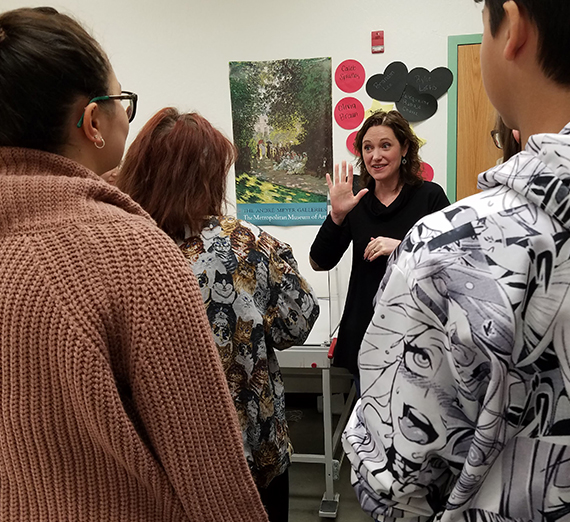The Art of Teaching

“I want my students to think about the world and their place in it,” says art teacher and Gonzaga alumna Pilar (Crooks) Biller (’96). “I want them to think for themselves but consider others’ perspectives. I want them to see challenges as the opportunity to learn. I want them to take creative risks and try new things. I want them to learn resilience and perseverance.”
Biller, an art teacher at Damonte Ranch High School in Reno, Nev., was elected 2018 Nevada State Teacher of the Year by the Nevada Department of Education. Biller will also be receiving the 2019 NEA Foundation Award for Teaching Excellence and the 2019 Nevada Art Educator Award.
From a young age, Biller’s family instilled in her a respect for the arts. As a student at Churchill County High School in Fallon, Nev., Biller explored her creative side through drama, choir, yearbook photography editing and debate. At Gonzaga, Biller received a work-study position as a model for art classes. Before long, she was inspired to join the students on the other side of canvas, and became an art major herself. Biller was also strongly influenced by the global perspectives she developed from traveling and studying art, religion and philosophy through the Gonzaga-in-Florence program. These experiences have been formative in shaping Biller’s goals, both for students and for herself, as a teacher.
“I have the incredible opportunity to teach these things through the arts,” Biller explains. “I think the support and encouragement I received as a student as well as the experiences I had in school contributed to my ability to foster this learning.”
After graduating from GU with her art degree, Biller continued to work and study part-time in Nevada, receiving her teacher certification from Sierra Nevada College, a master’s in education and certification by the National Board for Professional Teaching Standards. She currently teaches beginning art, intermediate art, advanced art, 2D/3D multimedia and AP art at Damonte Ranch High School in Reno, Nev. As a teacher, Biller says she is inspired by her students’ courage, perseverance and willingness to take creative risks with their art.
To help her students develop their independent creativity, problem-solving and initiative skills, Biller developed an Art Inquiry curriculum where artistic processes and scientific inquiry intersect. Her goal is to meet individual students’ needs and skills, guiding their independent thinking as they advance through the curriculum. Through art, Biller also encourages her students to connect with the community.
“Each year that I taught middle school, I arranged for several students to speak and present their art at a luncheon meeting of the Kiwanis Club, one of our Partners in Education,” she explains. “I wanted to strengthen our partnership by giving Kiwanis members a chance to meet some of the students and provide my students with an opportunity to share their artistic accomplishments beyond home and the classroom. The students’ confidence bloomed when Kiwanis members expressed how touched they were by the students’ personal stories and expressive artworks.”
At Damonte Ranch, Biller’s past students have collaborated with local elementary school students in an exhibit called the “Monster Project,” where high schoolers created art inspired by the children’s drawings of monsters. Biller also helps her high school students build confidence, communication skills and independence by assigning projects with real businesses and service organizations. By displaying their work in local galleries each year, learning about portfolios and event promotion during art museum visits, and meeting legislators to support the arts, Biller’s students cultivate professionalism and advocacy alongside their creative voices.
Biller, too, engages in academic and art advocacy in her free time. As a member of the National Art Education Association and Art Educators of Nevada, a National Board Certified Teacher and part of the Nevada ED Superintendent’s Teacher Advisory Cabinet, Biller promotes art programs, education reform and communication with legislators to spread awareness about education issues. She encourages other teachers to develop themselves professionally and to cultivate positive, encouraging relationships and communities in their classrooms. Simultaneously, she says, “Be reflective, hold yourself to high standards, but be patient with yourself.”
“Don’t expect to ever have it all figured out,” Biller advises. “The more you know about teaching, the more you realize there is so much more to learn.”

